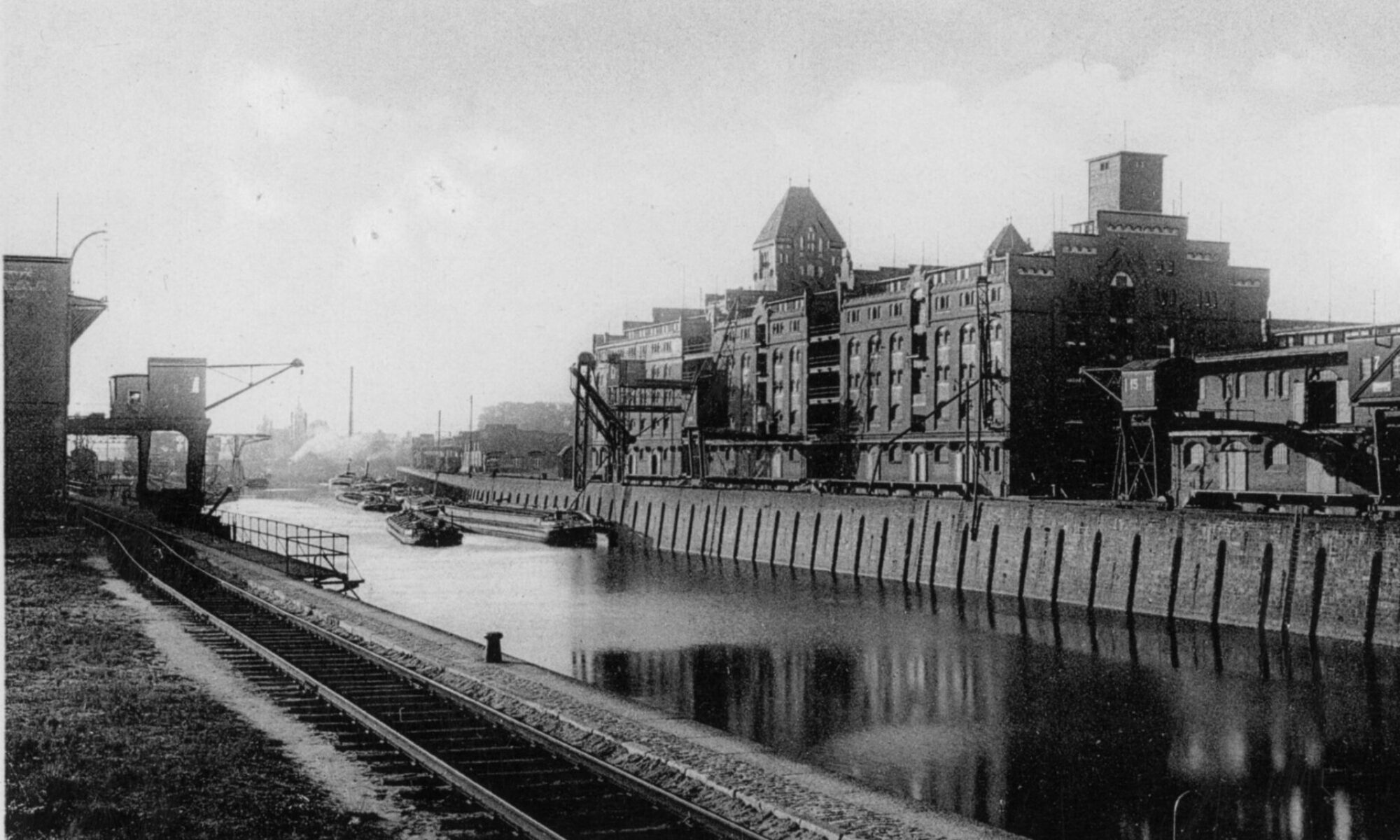Informujemy, że oferty na realizację zadania pn. Remont obrotnicy kolejowej, zlokalizowanej w biegu toru 304 na bocznicy kolejowej Muzeum Kolejnictwa na Śląsku, ul. Towarowa 4, 58-140 Jaworzyna Śląska, można składać do dnia 25.04.2025 r. Oferty należy składać w formie elektronicznej na adres: biuro@muzeatechniki.pl lub w siedzibie Fundacji Ochrony Dziedzictwa Przemysłowego Śląska; ul. Oławska 15, 50-123 (IV p).
Majówka w Folwarku
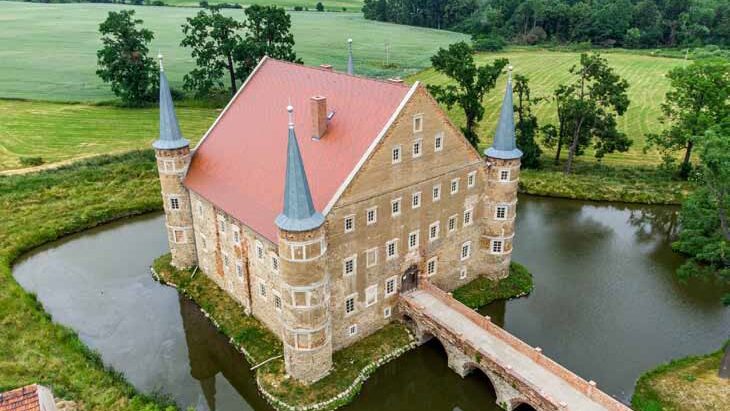
„Majówka w Folwarku” to 4 dni pełne atrakcji na świeżym powietrzu, który połączy zabawę, edukację i obcowanie z naturą i zabytkami. Podczas Majówki w Folwarku będzie można odpocząć na łonie natury, zjeść naturalne produkty, zwiedzić kolekcję zabytkowych maszyn rolniczych wraz z zamkiem.
Ramowy program wydarzenia:
1.05.2025 Czwartek
11:00-17:00
| Godziny | Wydarzenie |
|---|---|
| 11:30 / 12:30 / 13:30 / 15:00 / 16:00 | Zwiedzanie zamku i kolekcji maszyn rolniczych z przewodnikiem |
| 14:00-16:00 | Strefa gier i zabaw dla dzieci |
2.05.2025 Piątek
11:00-17:00
| Godziny | Wydarzenie |
|---|---|
| 11:30 / 12:30 / 13:30 / 15:00 / 16:00 | Zwiedzanie zamku i kolekcji maszyn rolniczych z przewodnikiem |
3.05.2025 Sobota
11:00-17:00
| Godziny | Wydarzenie |
|---|---|
| 11:30 / 12:30 / 13:30 / 15:00 / 16:00 | Zwiedzanie zamku i kolekcji maszyn rolniczych z przewodnikiem |
| 14:00-16:00 | Strefa gier i zabaw dla dzieci |
4.05.2025 Niedziela
11:00-17:00
| Godziny | Wydarzenie |
|---|---|
| 11:30 / 12:30 / 13:30 / 15:00 / 16:00 | Zwiedzanie zamku i kolekcji maszyn rolniczych z przewodnikiem |
| 14:00-15:00 | Pokazy zabytkowego ciągnika rolniczego Ferguson z 1947 r. |
Dodatkowe informacje:
Bilet Normalny 35 PLN / Bilet Ulgowy 30 PLN / Bilet rodzinny (2+2) 110 PLN
Na miejscu zapraszamy również do skorzystania z oferty gastronomicznej – smacznych domowych obiadów oraz łakoci.
Aktualności ZAMEK
W sobotę 29 marca zapraszamy na Wieczorne zwiedzanie i niezwykłą wędrówkę po Piotrowickim Folwarku, gdzie magia iluminowanych renesansowych murów pozostawi na zwiedzających niesamowite wrażenie. Nie zabraknie dreszczyku emocji i pasjonujących opowieści. Na zwiedzanie warto zabrać swoją latarkę i wygodne obuwie. Zwiedzanie rozpocznie się o godz. 16.00 i potrwa 2 godziny.
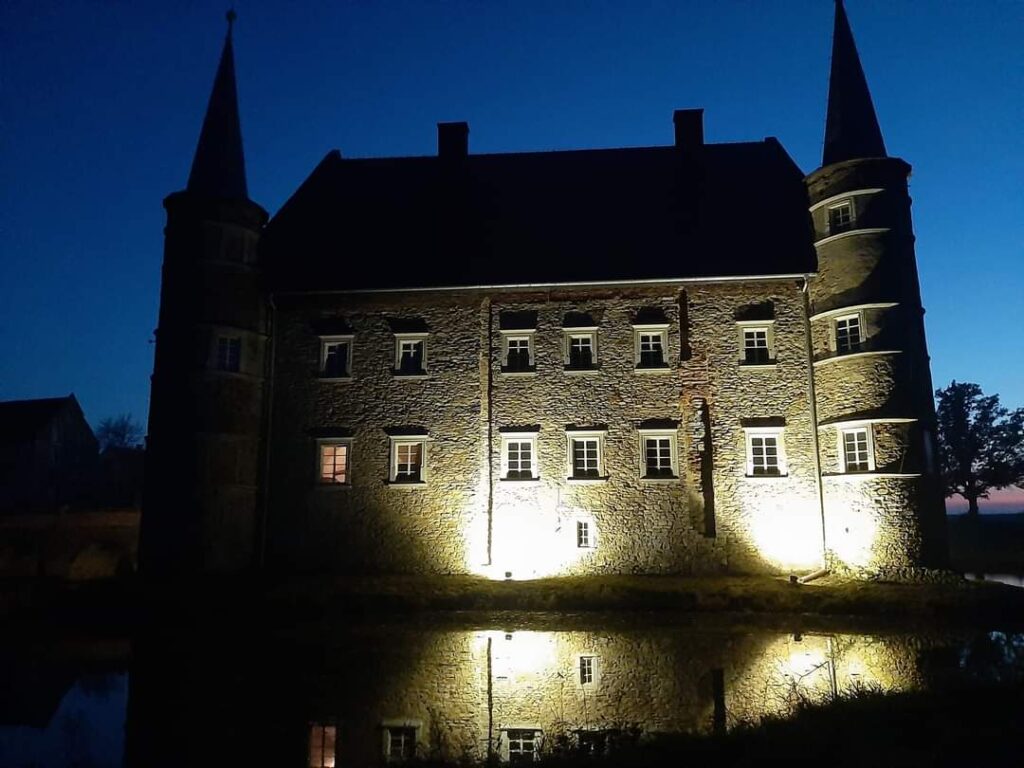
Natomiast w niedzielę 30 marca zapraszamy na warsztaty dla dzieci w niedzielę Ogród i jego dary. Podczas warsztatów zaprezentujemy w terenie – kwiaty, warzywa i zioła w ogrodzie, sianie, sadzenie i pielęgnacja. Dzieci dowiedzą się też o życiu owadów, którym zawdzięczamy owoce i warzywa. Tradycyjnie cały weekend zapraszamy za zwiedzanie historycznego Folwarku z zamkiem i kolekcją maszyn rolniczych w zabytkowej stodole.
Folwark czynny od 11.00 do 17.00
Warsztaty godz. 14.00
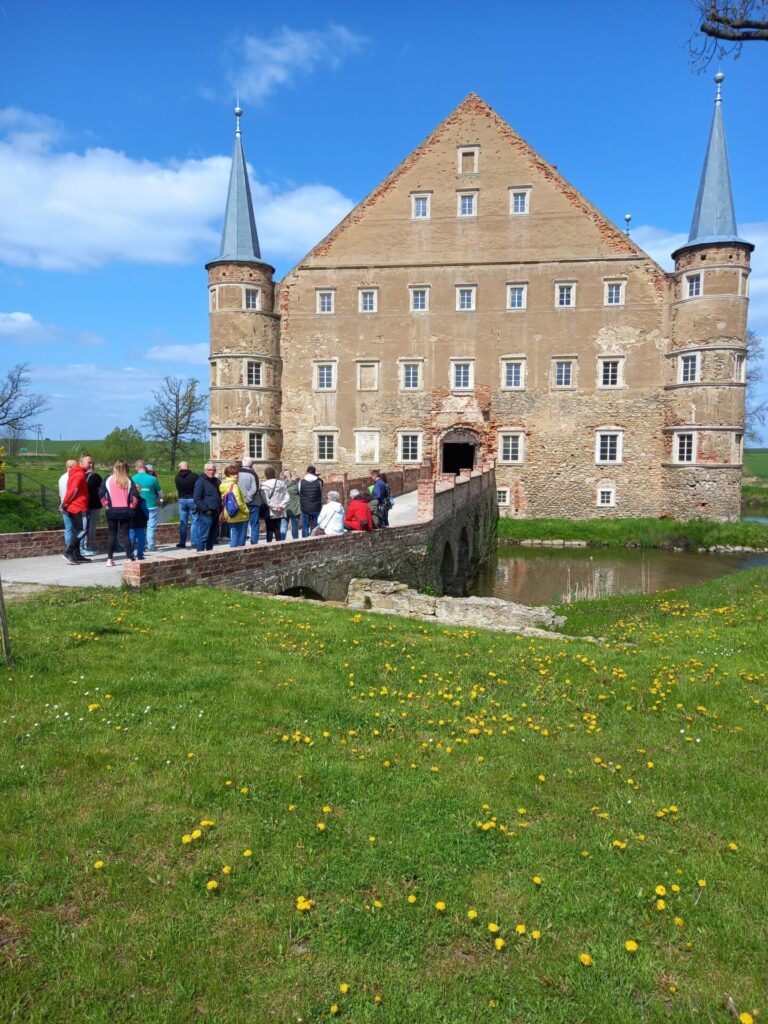
5.04.2025, sobota – Sobotni relaks w Folwarku od 11.00 do 17.00
Zapraszamy na wyjątkowy dzień w historycznym Folwarku! Zwiedzanie zamku oraz kolekcji zabytkowych maszyn rolniczych w klimatycznej stodole, a także chwile relaksu na leżakach, piknikowe kosze i ognisko. Idealny sposób na wiosenny odpoczynek!
12 i 13 kwiecień – Wielkanocny weekend
12.04.2025, sobota, zapraszamy na Warsztaty wielkanocne. To doskonała okazja do połączenia tradycji z kreatywną zabawą, a także do nauki o wiosennych zwyczajach i rękodziele. W folwarku rolniczym takie warsztaty, które wprowadzą uczestników w atmosferę Świąt Wielkanocnych związanych z przyrodą, wiosną oraz tradycjami ludowymi.
Warsztaty na których przygotujemy z dziećmi ozdoby świąteczne oraz palmy wielkanocne: godz. 14.00 – 15.00
21.04.2025 – Lany Poniedziałek – w drugi dzień Świąt Wielkanocnych zapraszamy do Wiosennej Gry Terenowej o godz. 14.00 do 15.00 z poszukiwaniem czekoladowych jajek, w ogrodzie.
Zapytanie ofertowe 1/2025/Interreg


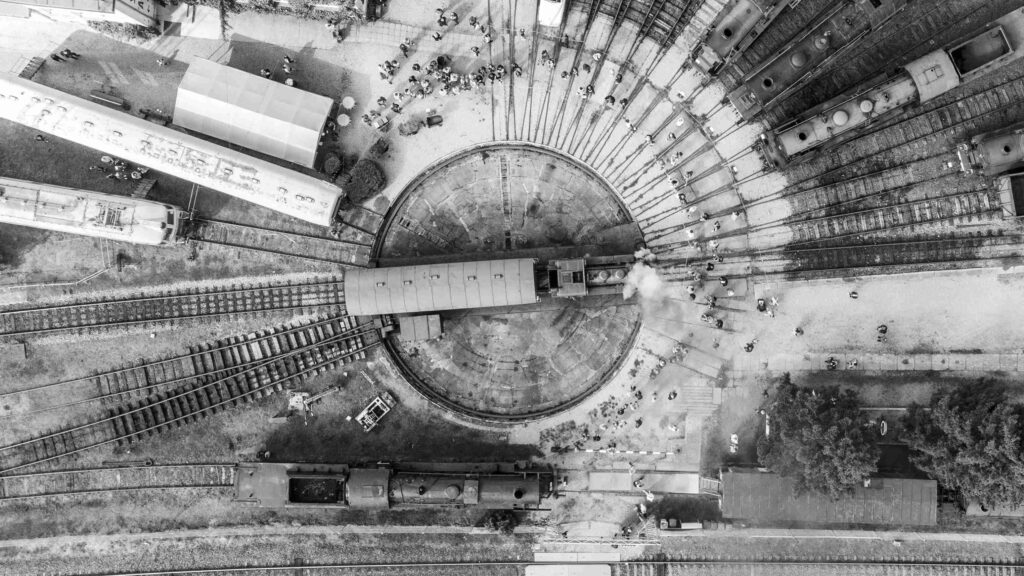
Przedmiotem zamówienia jest remont obrotnicy kolejowej zlokalizowanej w biegu toru 304 na bocznicy kolejowej Muzeum Kolejnictwa na Śląsku, ul. Towarowa 4, 58-140 Jaworzyna Śląska. Prace realizowane będą w ramach realizowanego przez Fundację Ochrony Dziedzictwa Przemysłowego Śląska projektu w ramach programu Interreg Czechy-Polska pn. Kolej łączy kultury, o numerze rej. CZ.11.02.01/00/23_004/0000100.
| Termin składania ofert | 20.04.2025 r. |
| Adres dla ofert składanych listownie | Fundacja Ochrony Dziedzictwa Przemysłowego Śląska ul. Oławska 15, 50-123 Wrocław z dopiskiem „Interreg” |
| Adres e-mail dla ofert składanych elektronicznie: | biuro@muzeatechniki.pl |
Zapytanie ofertowe
Formularz ofertowy
Wykaz zrealizowanych usług
Wzór umowy
Konferencja
W trakcie planowanej konferencji „Europejskie Dziedzictwo Węgla i Stali” kontynuowany będzie, podjęty w 2023 roku temat ochrony i zachowania dziedzictwa przemysłowego w Europie. W 2023 roku uczestnicy konferencji pod tytułem: „Dziedzictwo przemysłowe w sercu Zielonej Europy” dyskutowali nad kierunkami ochrony zabytków kultury technicznej, szczególnie tych związanych z wykorzystaniem paliw kopalnych.
The planned conference „European Steel and Coal Heritage” will continue the discussions initiated in 2023 on the protection and preservation of industrial heritage in Europe. Participants at the conference titled “Industrial Heritage in the Heart of Green Europe” discussed directions for protecting industrial heritage, particularly related to the use of fossil fuels.
Ferie w Muzeach Techniki
Fundacja Ochrony Dziedzictwa Przemysłowego Śląska serdecznie zaprasza na tegoroczne ferie zimowe do muzeów techniki, gdzie przygotowano szereg atrakcji dla odwiedzających w każdym wieku.
Muzeum Porcelany Śląskiej w Tułowicach oferuje warsztaty, podczas których uczestnicy będą mogli poznać tajniki tworzenia porcelany oraz własnoręcznie ozdobić porcelanowe wyroby. To doskonała okazja, aby zgłębić historię i proces produkcji tego delikatnego materiału.
Muzeum Kolejnictwa na Śląsku w Jaworzynie Śląskiej przygotowało dla miłośników kolei możliwość zwiedzania zabytkowych lokomotyw i wagonów. Dodatkowo, planowane są przejażdżki zabytkowymi pociągami, które przeniosą uczestników w czasy świetności kolei parowej.
Młyn Hilberta w Dzierżoniowie odwiedzający będą mieli okazję zobaczyć, jak dawniej mielono zboże oraz poznać historię młynarstwa.
Muzeum Hutnictwa Cynku „Walcownia” w Katowicach przygotowało specjalne oprowadzania po zabytkowej walcowni, gdzie będzie można zobaczyć proces produkcji blach cynkowych oraz poznać historię hutnictwa w regionie.
Dla tych, którzy chcieliby odwiedzić wszystkie te miejsca, Fundacja oferuje Złoty Bilet – karnet w cenie 100 zł, który uprawnia do wielokrotnego wstępu do wszystkich pięciu muzeów przez cały 2025 rok. To również doskonały pomysł na prezent dla pasjonatów techniki i historii.
Serdecznie zachęcamy do skorzystania z oferty i spędzenia ferii w otoczeniu fascynujących zabytków techniki, które przybliżą historię przemysłu.
Jak kiedyś funkcjonowały gospodarstwa rolne
Uratowany dwór w Piotrowicach Świdnickich jest obecnie siedzibą Muzeum Techniki Rolniczej
Dwór w Piotrowicach Świdnickich w powiecie świdnickim został zbudowany przez Jacoba von Zedlitza w latach 1590-1599. Zygmunt Nostitz został nowym właścicielem Piotrowic w 1622 roku. Swoją rezydencję przeniósł do Łażan. Od tego momentu oba majątki były zarządzane z Łażan. Dwór w Piotrowicach Św. służył jako dom zarządcy majątku i jego pomocników. Podczas wojny trzydziestoletniej majątek i dwór zostały doszczętnie splądrowane i zrujnowane. Zniszczeniu uległy budynki gospodarcze, zwłaszcza młyn i wiatrak. Majątek pozostawał w rękach potomków rodziny Nostitz przez kilkadziesiąt lat. W tym czasie na terenie posiadłości wzniesiono kolejne budynki i przebudowano dwór. W 1770 r. Beata Abigail, bezdzietna wdowa po Karlu Gottlibie von Nostitz, zapisała majątek swojemu bratankowi hrabiemu Nikolausowi Augustowi Wilhelmowi von Burghaus.
Niegdyś jeden z największych majątków na Dolnym Śląsku
W 1775 r. hrabia stał się właścicielem dóbr w Piotrowicach Św., Żarow i Łażan. Dwór został gruntownie przebudowany, a do majątku dobudowano kolejne budynki. Nowy właściciel, filantrop, budowniczy i członek wielu stowarzyszeń, finansował liczne działania charytatywne i naukowe. Był inicjatorem i inwestorem pierwszego żeliwnego mostu na kontynencie, który został zbudowany w pobliskich Łażanach w 1796 roku. Jego działalność charytatywną kontynuował syn Friedrich Burghaus, który w 1854 r. wybudował na terenie zamku Piotrowic Św. szpital – przytułek dla mieszkańców okolicznych wiosek. Po śmierci Friedricha majątek pozostał w posiadaniu rodziny Pfeil-Burghaus do 1945 r. ze względu na powiązania rodzinne.
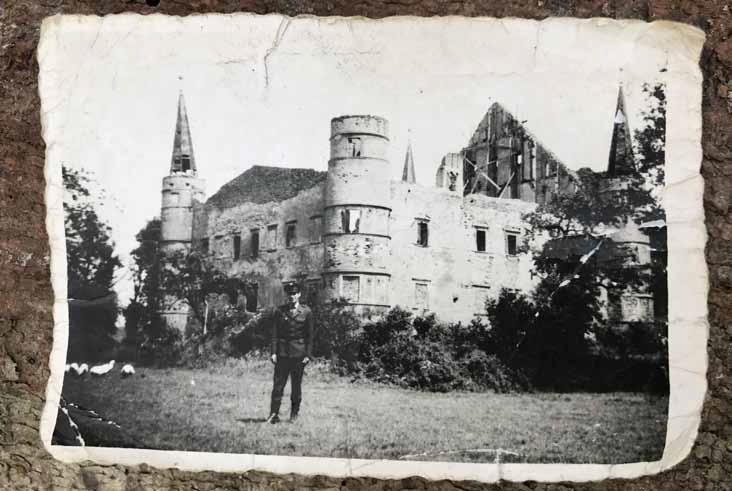
Widok zamku w 1957 r., fot. Fundacja Ochrony Dziedzictwa Przemysłowego Śląska
W XIX i XX w. aż do 1945 r. wieś, a wraz z nią dwór i majątek przeżywały pomyślny rozwój. Przebudowano dwór, rozbudowano i zmodernizowano majątek. W majątku przechowywano plony z kilkuset hektarów ziemi, hodowano krowy, świnie i konie. Zboże przechowywano w dużym czterokondygnacyjnym spichlerzu z połowy XVIII wieku. Dla dużych zwierząt zbudowano murowane stajnie z krytymi dachówką sufitami i kilkudziesięcioma boksami. Słomę, siano i ziemniaki przechowywano w dwóch dużych stodołach. Była to jedna z największych posiadłości na Dolnym Śląsku.
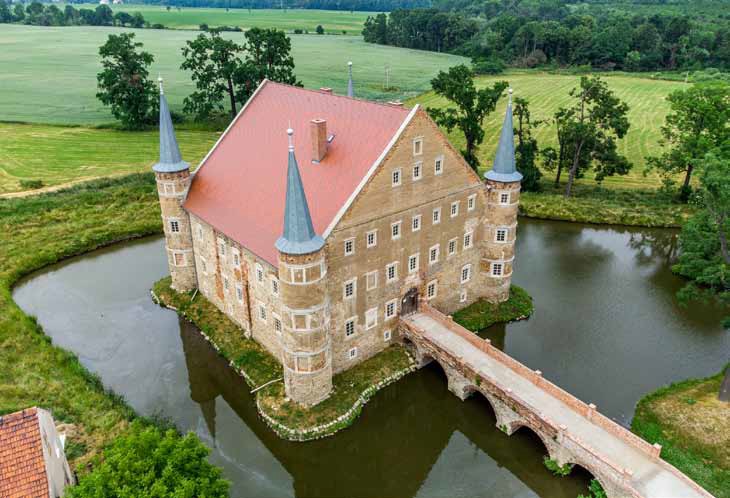
Południowa strona zamku, fot. Przemysław Durr 2022
Rozpad po 1945 r. i renowacja od 2007 r.
Po 1945 r. majątek Piotrowic Św. popadł w ruinę i nie był już użytkowany. Do końca lat 90-tych majątek był wykorzystywany jako część PGR. Po zamknięciu gospodarstwa popadł w ruinę. W latach 1972-1976 zabytkowy dwór został częściowo odrestaurowany. Między innymi odrestaurowano więźbę dachową. W kolejnych latach budynek popadał w ruinę. Od 2007 roku, w ramach działań Fundacji Ochrony Dziedzictwa Przemysłowego Śląska, trwają prace nad odbudową zespołu dworskiego na potrzeby Muzeum Techniki Rolniczej. W wyremontowanych budynkach mieścić się będzie muzeum, które prezentować będzie historię rozwoju rolnictwa oraz warunki życia w gospodarstwach rolnych na Śląsku w XIX i na początku XX wieku.
Interesująca prezentacja maszyn i budynków rolniczych
Ważną częścią muzeum jest ekspozycja maszyn wykorzystywanych w rolnictwie w XIX i XX wieku. W zrekonstruowanej stodole z drugiej połowy XVIII wieku znajduje się ekspozycja różnego rodzaju maszyn rolniczych pochodzących ze śląskich fabryk, a także kolekcja zabytkowych ciągników różnych marek. Większość maszyn jest sprawna. W ramach organizowanych przez muzeum wydarzeń zwiedzający mogą zobaczyć pracujące maszyny, które prezentują warunki pracy w gospodarstwie rolnym. Odwiedzający muzeum mogą przekonać się, jak wyglądała orka konna lub różnymi typami ciągników, a także jak kosiło się zboże dawnymi maszynami.
W skład fundacji wchodzi obecnie pięć muzeów: Muzeum Kolejnictwa na Śląsku w Jaworzynie Śląskiej, Muzeum Hutnictwa Cynku „Walcownia” w Katowicach, Młyn Hilberta w Dzierżoniowie, Muzeum Porcelany Śląskiej w Tułowicach k/ Opola oraz Muzeum Techniki Rolniczej w Piotrowicach Świdnickich.
Atrakcją jest zwiedzanie XVIII-wiecznego spichlerza, w którym można poznać dawne metody przechowywania żywności. Na terenie muzeum znajduje się również sad i dziesięciohektarowy ogród. Muzeum ma swoich mieszkańców: opiekuje się zwierzętami gospodarskimi. Obecnie mieszka tu krowa Lala i stado baranów. Na terenie muzeum znajduje się duża pasieka. Miód zebrany przez pszczoły można kupić w muzealnej restauracji.
Muzeum jest otwarte dla turystów w każdy weekend oraz w wybrane dni wiosną i latem. Kalendarz wydarzeń w muzeum można znaleźć tutaj.
Fundacja Ochrony Dziedzictwa Przemysłowego Śląska
Najważniejszą działalnością fundacji jest ochrona wybranych obiektów techniki charakterystycznych dla Śląska. Ochrona odbywa się przede wszystkim poprzez przekształcenie chronionego zabytku w muzeum. Ochrona poprzez „muzealizację” realizowana jest według różnych modeli. Wybór formy ochrony ma na celu przede wszystkim maksymalną ochronę i jak najlepsze zachowanie oryginalności i autentyczności chronionego zabytku. Przy wyborze obiektu do ochrony brane są pod uwagę obiekty o szczególnym znaczeniu dla regionu oraz reprezentujące najważniejsze gałęzie przemysłu rozwinięte na Górnym lub Dolnym Śląsku.
W skład fundacji wchodzi obecnie pięć muzeów: Muzeum Kolejnictwa na Śląsku w Jaworzynie Śląskiej, Muzeum Hutnictwa Cynku „Walcownia” w Katowicach, Walcownia Hilberta w Dzierżoniowie, Muzeum Porcelany Śląskiej w Tułowicach k/ Opola, Muzeum Techniki Rolniczej w Piotrowicach Świdnickich.
Planowane są kolejne dwa oddziały: Walcownia Cynku Lipiny w Świętochłowicach oraz Muzeum Kolejnictwa w Dzierżoniowie, jako oddział muzeum w Jaworzynie Śląskiej.

Wie Bauernhöfe funktionierten
Das gerettete Schloss Peterwitz/Piotrowice Świdnickie beherbergt heute ein Museum für Landtechnik
Der Erbauer des Herrenhauses in Peterwitz/Piotrowice Świdnickie im Kreis Schweidnitz war Jacob von Zedlitz, der den Bau zwischen 1590 und 1599 durchführte. 1622 wurde Sigismund Nostitz der neue Besitzer von Peterwitz. Er verlegte seinen Wohnsitz nach Laasan/Łażany. Von da an wurden beide Güter von Laasan aus verwaltet. Das Gutshaus in Peterwitz diente als Wohnung des Gutsverwalters und seiner Gehilfen. Während des Dreißigjährigen Krieges wurden das Gut und der Gutshof vollständig geplündert und ruiniert. Die Wirtschaftsgebäude wurden zerstört, vor allem die Mühle und die Windmühle. Das Gut blieb mehrere Jahrzehnte lang in den Händen der Nachkommen der Familie Nostitz. In dieser Zeit wurden weitere Gebäude auf dem Gutshof errichtet und das Herrenhaus wurde wieder aufgebaut. 1770 vererbte Beata Abigail, die kinderlose Witwe von Karl Gottlib von Nostitz, das Gut an ihren Neffen Graf Nikolaus August Wilhelm von Burghaus.
Einst einer der größten Gutshöfe in Niederschlesien
Im Jahr 1775 wurde der Graf Eigentümer der Güter Pe- terwitz, Saarau/Żarow und Laasan. Das Herrenhaus wurde umfangreich umgebaut und das Gehöft um weitere Gebäude erweitert. Der neue Eigentümer, Philanthrop, Baumeis- ter und Mitglied zahlreicher Vereine finanzierte zahlreiche wohltätige und wissenschaftliche Aktivitäten. Er war der Initiator und Investor der ersten Brücke aus Gusseisen auf dem Kontinent, die 1796 im nahe gelegenen Laasan gebaut wurde. Seine wohltätigen Aktivitäten wurden von seinem Sohn Friedrich Burghaus fortgesetzt, der 1854 auf dem Gelände des Schlosses Peterwitz ein Krankenhaus – ein Asyl für die Bewohner der umliegenden Dörfer – errichtete. Nach Friedrichs Tod blieb das Gut aufgrund familiärer Verbindungen bis 1945 im Besitz der Familie Pfeil-Burghaus.

Schlossansicht im Jahr 1957, Foto: Stiftung
Im 19. und 20. Jahrhundert bis 1945 erlebten das Dorf und mit ihm das Gut und der Gutshof eine gedeihliche Entwicklung. Das Herrenhaus wurde weiter umgebaut, und der Gutshof wurde erweitert und modernisiert. Auf dem Gutshof wurde die Ernte von mehreren hundert Hektar Land eingelagert; man züchtete hier Kühe, Schweine und Pferde. Das Getreide wurde in einem großen vierstöckigen Getreidespeicher aus der Mitte des 18. Jahrhunderts gelagert. Für die großen Tiere wurden gemauerte Ställe mit Ziegeldecken und mit mehreren Dutzend von Boxen gebaut. Stroh, Heu und Kartoffeln wurden in zwei großen Scheunen eingelagert. Es war einer der größten Gutshöfe in Niederschlesien.

Schloss Südseite, Foto: Przemyslaw Durr 2022
Verfall nach 1945 und Sanierung seit 2007
Nach 1945 lag das Gut Peterwitz in Trümmern und wurde nicht mehr genutzt. Bis Ende der 1990er Jahre wurde der Gutshof als Teil des Staatlichen landwirtschaftlichen Betriebs/ PGR genutzt. Nach der Einstellung des Betriebs verfiel er. Zwischen 1972 und 1976 wurde eine Teilkonservierung des historischen Gutshauses durchgeführt. Unter anderem wurde der Dachstuhl wiederhergestellt. In den Folgejahren verfiel das Gebäude. Seit 2007 wird im Rahmen der Aktivitäten der Stiftung zum Schutz des industriellen Erbes Schlesiens daran gearbeitet, den Gutshofkomplex für die Zwecke des Niederschlesischen Museums für Landtechnik umzubauen. Die renovierten Gebäude werden das Museum beherbergen, das die Geschichte der Entwicklung der Landwirtschaft und die Lebensbedingungen auf den Bauernhöfen in Schlesien im 19. und Anfang des 20. Jahrhunderts zeigt.
Spannende Präsentation von Landmaschinen und Gebäuden
Ein wichtiger Teil des Museums ist die Ausstellung der im 19. und 20. Jahrhundert in der Landwirtschaft eingesetzten Maschinen. Die rekonstruierte Scheune aus der zweiten Hälfte des 18. Jahrhunderts beherbergt eine Ausstellung verschiedener Arten von Landmaschinen aus schlesischen Fabriken sowie eine Sammlung historischer Traktoren verschiedener Marken. Die meisten der Maschinen sind funktionstüchtig. Im Rahmen der organisierten Veranstaltungen des Museums können die Besucher Arbeitsmaschinen sehen, die die Arbeitsbedingungen auf einem Bauernhof präsentieren. Die Museumsgäste können sehen, wie es war, mit dem Pferd oder mit verschiedenen Traktorentypen zu pflügen, oder wie das Getreide mit alten Maschinen gemäht und mit einer Dampfmaschine gedroschen wurde.
Die Stiftung umfasst derzeit fünf Museen: Museum für Eisenbahnwesen in Schlesien in Königszelt/Jaworzyna Śląska, Museum für Zinkmetallurgie „Walzwerk“ in Katto- witz/Katowice, Hilbert-Mühle in Reichenbach/Dzierżoniów, Museum für schlesisches Porzellans in Tillowitz/Tułowice bei Oppeln/Opole, Museum für Landtechnik in Peterwitz/ Piotrowice Świdnickie (Kreis Schweidnitz).
Ein Höhepunkt ist die Besichtigung des Getreidespeichers aus dem 18. Jahrhundert, in dem man etwas über die alten Methoden der Nahrungsmittellagerung erfahren kann. Das Museum verfügt über einen Obstgarten sowie ten wachsen. Das Museum hat seine eigenen Bewohner: es kümmert sich nämlich um Nutztiere. Derzeit leben hier die Kuh Lala und eine Hammelherde. Auf dem Gelände gibt es eine große Imkerei. Der von den Bienen gesammelte Honig kann im Restaurant des Museums erworben werden.
Das Museum ist jedes Wochenende und an ausgewählten Tagen im Frühjahr und Sommer für die Touristen geöffnet. Einen Veranstaltungskalender des Museums finden Sie unter.
Stiftung zum Schutz des industriellen Erbes Schlesiens
Die wichtigste Tätigkeit der Stiftung ist der Schutz ausgewählter technischer Objekte, die für Schlesien charakteristisch waren. Der Schutz erfolgt in erster Linie durch die Umwandlung des geschützten Denkmals in ein Museum. Der Schutz durch „Musealisierung“ erfolgt nach verschiedenen Modellen. Die Wahl der Schutzform zielt in erster Linie auf den maximalen Schutz und die bestmögliche Erhaltung der Originalität und Authentizität des geschützten Denkmals ab. Bei der Auswahl eines zu schützenden Objekts werden Objekte von besonderer Bedeutung für die Region und solche, die die wichtigsten in Ober- oder Niederschlesien entwickelten Industriezweige repräsentieren, berücksichtigt.
Die Stiftung umfasst derzeit fünf Museen: Museum für Eisenbahnwesen in Schlesien in Königszelt/Jaworzyna Śląska, Museum für Zinkmetallurgie „Walzwerk“ in Katto- witz/Katowice, Hilbert-Mühle in Reichenbach/Dzierżoniów, Museum für schlesisches Porzellans in Tillowitz/Tułowice bei Oppeln/Opole, Museum für Landtechnik in Peterwitz/ Piotrowice Świdnickie (Kreis Schweidnitz).
Weitere zwei Einheiten sind in Planung: Zinkwalzwerk Lipine/Lipiny in Schwientochlowitz/Świętochłowice bei Beuthen/Bytom und Eisenbahnmuseum in Reichenbach/ Dzierżoniów: eine Zweigstelle des Museums in Königszelt/ Jaworzyna Śląska.
Złoty Bilet – pomysł na prezent
Fundacja Ochrony Dziedzictwa Przemysłowego Śląska to największa w Polsce, niezależna organizacja pozarządowa zajmująca się planową ochroną i promocją zabytków techniki. Najważniejszą działalnością Fundacji jest ochrona wybranych, charakterystycznych dla Śląska zabytków kultury technicznej. Ochrona odbywa się przede wszystkim poprzez przekształcenie chronionego zabytku w muzeum.
Obecnie w ramach Fundacji działa:
- Muzeum Kolejnictwa w Jaworzynie Śląskiej 🚃
- Muzeum Hutnictwa Cynku Walcownia w Katowicach 🏭
- Młyn Hilberta w Dzierżoniowie🌾
- Muzeum Porcelany Śląskiej w Tułowicach 🍵
- Muzeum Techniki Rolniczej w Piotrowicach Świdnickich 🚜
Teraz możesz je zwiedzać przez cały 2025 rok kupując Złoty Bilet w cenie 100 zł. Jest to bilet „5 w 1” wielorazowego użytku – upoważnia do wstępu do wszystkich naszych muzeów w 2025 roku.
Złoty Bilet to:
![]() Wielokrotny, darmowy wstęp do wszystkich obiektów Fundacji
Wielokrotny, darmowy wstęp do wszystkich obiektów Fundacji
![]() Wstęp na organizowane w obiektach wydarzenia, w tym Gala Parowozów
Wstęp na organizowane w obiektach wydarzenia, w tym Gala Parowozów ![]()
![]() Bilet ważny do 31 grudnia 2025
Bilet ważny do 31 grudnia 2025
![]() Świetny pomysł na prezent
Świetny pomysł na prezent ![]()
![]()
![]()
Napisz na muzeum@muzeatechniki.pl i zamów jeszcze dziś!

Magia Świąt w Muzeach Techniki!
Mamy dla Was sporo świątecznych atrakcji!
- Muzeum Kolejnictwa w Jaworzynie Śląskiej zaprasza na niezwykłą podróż do Stacji Świętego Mikołaja! 🚂 czeka na Was mnóstwo atrakcji:
- 1 grudnia – Niedziela z Warszawą M20 – pokazy przejażdżki zabytkowej drezyny M20
- w dniach 2-6, 9-13 i 16-20 grudnia – Zwiedzanie, spotkania ze Świętym Mikołajem
- prawdziwa niszczarka złych uczynków – idealna dla małych urwisów, aby mogli rozpocząć świąteczny czas z czystym kontem!
- napisz swój wymarzony list do Świętego Mikołaja w wyjątkowej atmosferze!
- 7 i 8 grudnia – Mikołajowa gra terenowa na bocznicy Muzeum Kolejnictwa na Śląsku z prezentami, przejażdżki lokomotywą Św. Mikołaja i familijne zwiedzanie świątecznego muzeum
- 14 i 15 grudnia – Kolejowe Warsztaty Świąteczne – wykonanie unikatowej ozdoby świątecznej na zabytkowych maszynach w zabytkowym kolejowym warsztacie, przejażdżki lokomotywą Św. Mikołaja , familijne zwiedzanie Świątecznego Muzeum
- 21 i 22 grudnia – Mikołajowa gra terenowa na bocznicy Muzeum Kolejnictwa na Śląsku z prezentami! Przejażdżki lokomotywą Św. Mikołaja oraz Familijne zwiedzanie świątecznego muzeum, a od godz. 16.00 Wieczorne zwiedzanie Muzeum Kolejnictwa na Śląsku w świątecznej iluminacji
- w dniach 26-30 grudnia Gra terenowa na bocznicy Muzeum Kolejnictwa na Śląsku z prezentami! Przejażdżki lokomotywą Św. Mikołaja oraz Familijne zwiedzanie świątecznego muzeum
- czekamy na Was codziennie (z wyjątkiem 24 i 25 grudnia), nie przegapcie tej świątecznej przygody!
- 31 grudnia zapraszamy miedzy godz. 16.00 a 18.00 na Sylwestrowe zwiedzanie Muzeum Kolejnictwa
- Muzeum Porcelany Śląskiej w Tułowicach zaprasza już dziś na Porcelanowe Boże Narodzenie!
- do 22 grudnia 2024 🎄 warsztaty tworzenia ozdób świątecznych – otwarte od wtorku do niedzieli
- prezenty, które zachwycą każdego!🎁 kiermasz porcelanowych prezentów – znajdziesz tu m.in. piękne bombki malowane tradycyjnym wzorem opolskim oraz inne rękodzieła, które dodadzą uroku Twoim świętom
- 26 grudnia, a także 1 i 6 stycznia unikalne zwiedzanie, pełne pasji historie o porcelanowych arcydziełach i ich znaczeniu w kulturze i sztuce 🎅🎄 Na zakończenie darmowy poczęstunek w eleganckim otoczeniu muzealnych wnętrz.
- Młyn Hilberta w Dzierżoniowie serdecznie zaprasza na wyjątkowe świąteczne wydarzenia! 🌟 8 i 27 grudnia 2024 to szczególne dni pełne magii, rodzinnych atrakcji i świątecznej atmosfery. Niech dźwięk zabytkowych maszyn i zapach bożonarodzeniowych specjałów przeniosą Was w niezapomniany świat dawnych tradycji! 8 grudnia Mikołajki w Młynie Hilberta, warsztaty dla dzieci i.. kolejkowo! a 27 grudnia świąteczne, nocne zwiedzanie Młyna Hilberta!
- Muzeum Techniki Rolniczej w Piotrowicach Świdnickich -🎄 7 i 8 grudnia specjalne świąteczne warsztaty dla dzieci, zwiedzanie magicznego zamku oraz zabytkowych maszyn, gorąca herbata i piernik w spichlerzu! Aby wziąć udział w warsztatach prosimy o rezerwację w arkuszu
- Muzeum Hutnictwa Cynku WALCOWNIA w Katowicach – od 1 do 13 grudnia wystawa Zabytkowe kufle górnicze Pod opieką św. Barbary. Wizerunki świętej w śląskich kopalniach, a od 14 grudnia do 31 stycznia Walcownia zaprasza na świąteczną wystawę Bombki z historią!
🎅 Nie zwlekaj – w tym roku Święta zaczynają się już teraz! Czekamy na Ciebie z mnóstwem radości i inspiracji! 🎁✨
Przeczytaj też Złoty bilet – pomysł na prezent
